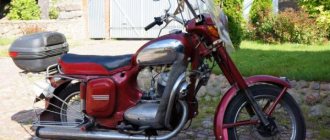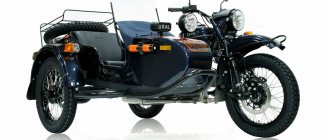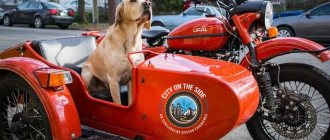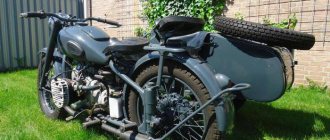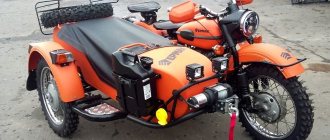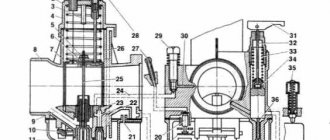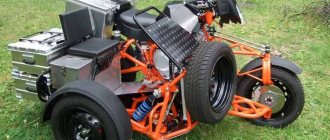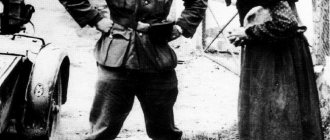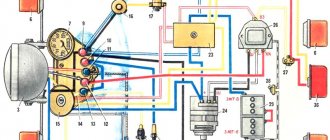The Ural motorcycle is not only history, but also part of the life of our people. The greatest achievement of the manufacturer is how the Ural moves through mud, the concept of the plant is based on this.
Several generations have ridden on the famous Ural motorcycles, which have proven themselves to be the best. And in rural areas they are still in demand as inexpensive, practical and reliable equipment for everyday use.
Ural is an ideal cross-country motorcycle for rural areas
History of the Ural model
First, it is worth recalling that the first all-wheel drive motorcycles appeared in England about 100 years ago. For a long time they had no competitors in terms of price-quality ratio. Subsequently, BMW began production of a military modification of such equipment.
It is believed that military all-wheel drive options made such motorcycles very popular. At least in our country, after the Great Patriotic War, the production of German military “clones” began.
Over time, through modifications and improvements, the domestic market received excellent, reliable and practical equipment for various purposes. They were used by the police and various inspections; they were highly valued by the villagers. At that time, cars were in short supply, so the Ural motorcycle was an excellent alternative to scarce vehicles.
The troops were equipped with machine guns and anti-tank installations. It was a very effective weapon. But over time, under pressure from the development of military technology, they were abandoned. Since then, the Ural model range has expanded greatly.
Point X - mid-70s
— When I was in Japan, I visited their motorcycle museum. So, it’s very clear how they have dramatically rushed forward since the mid-70s. And at that time we just slowed down. We were severely limited in new materials. If capitalists were already making titanium frames, then we couldn’t even dream about it,” says Nikolai Volozhanin (but the world’s largest titanium production enterprise, VSMPO-Avisma, is located in the Sverdlovsk region, in Verkhnyaya Salda. – Note. “ OG").
The Sverdlovsk people slowed down not because they lacked technical ideas. They were - and what kind of ones! But at that time there were no motorcycles with sidecars for free sale; the demand for them greatly outstripped the supply. Probably, someone at the top thought that in this situation there was no point in spending money and resources on modernization. A typical example is the fate of the best motorcycle from the Irbit plant, M-73. For 1980, when it was created, it was an advanced development.
“I tested this motorcycle myself,” says Alexander Bulanov. — Amazing car: powerful 750 cc engine, electric start, hydraulic brakes. More than a dozen original inventions were obtained by the plant’s specialists when creating this model. We tested it and got the go-ahead for mass production. But to release a new product for the first five years, 4.8 million rubles were required. The plant never received them, although it generated a net profit of more than 20 million rubles annually. M-73 never went into production...
Irbitsk residents issued the millionth motorcycle in 1975, the two millionth in 1985, and the three millionth in 1993. The largest number of motorcycles - 131 thousand - was produced in 1992. Then there was a decline in production: 1993 - 121 thousand, 1994 - 68,700, 1995 - only 11,700. Why did this happen?
“The main reason is that there is no consumer,” says Nikolai Volozhanin. — When prices were lowered in the early 90s and wages fell, rural workers and residents of small towns no longer had time to buy a new motorcycle; most did not have enough money to live on.
Modern trends in Ural motorcycles
Modern specimens are used more for tourism, by rural residents, and bikers from the Urals. After a little modification the bikes turn out to be quite good. This technique is very popular in the West. And after they began to be equipped with imported parts, sales abroad increased significantly.
Therefore, the lion's share of such motorcycles produced now is exported. At the moment, the manufacturer produces the Ural motorcycle of several modifications, each of which has its own “zest”:
- The tourist is a classic of the genre. A reliable and time-tested specimen, which exhibits all the best qualities of previous modifications. More popular among residents of rural areas for its performance and ease of use. As already mentioned, the reliability of the equipment is supported by the presence of many imported parts such as well-known ones, “DENSO”, “Sachs”;
- Tourist T is a modified version of the previous generation, aimed at long-term travel. Capable of carrying up to 280 kg of passengers and cargo. Outside the highway, all-wheel drive provides good cross-country ability. Abroad, the Ural motorcycle is one of the most inexpensive and popular models sold;
- Wolf is an option more aimed at fans of American choppers. Real members of the Night Wolves biker club helped develop this model. It has an extended wheelbase, excellent acceleration dynamics and a maximum speed of up to 150 km/h. The modern appearance of the model provides it with stable consumer demand;
- Solo is a single road bike that has already become a classic in this segment. It is more designed for highway driving and is in deserved demand among lovers of such entertainment. The chrome-plated gas tank and roll bars give it an unforgettable appearance. Stylized to resemble motorcycles from the middle of the last century;
- Sportsman - in 2006, the plant began producing a sports version of an all-wheel drive bike. The model was aimed at young people; one of the improvements was a switchable wheel drive on the side stroller. The modified stroller makes this model desirable for hunters, fishermen and simply lovers of outdoor activities. It has a roll bar, a large rear trunk and a windshield that protects from wind and oncoming splashes;
- Retro - modern Ural, stylized as models of past years. The stylized gear shift knob on the gas tank gives this model a special chic. Antique lovers love this model;
- Yamal . The model was released in honor of the famous icebreaker and is made in its colors. Symbolizes the reliability and maneuverability of the famous icebreaker. Released in limited edition.
Motorcycle "URAL" history of creation
The history of motorcycles of the IMZ (Ural) brand began in 1940. The BMW R71 motorcycle was taken as the basis.
which was ordered to be carefully copied. For these purposes, 5 motorcycles , to maintain secrecy, in Sweden - and reproduced. began manufacturing the motorcycle , which received the M-72 , in 1941 - in Moscow, Leningrad and Kharkov. The plant assembled Ural motorcycle But the outbreak of war forced the evacuation of the equipment of these factories far to the east, to the Ural city of Irbit motorcycles was launched in a short time . But still, the needs of the Red Army for motor vehicles during the Great Patriotic War were met mainly through lend-lease supplies from the USA and Great Britain. In particular, motorcycle was exported to the United States until 1945.
However, after the start of the Great Patriotic War, work to expand the production of motorcycle began to intensify. But the offensive of the German troops was rapid: on October 20, 1941, Moscow was declared in a state of siege, and the next day, October 21, the Evacuation Council under the Council of People's Commissars of the USSR decided to transfer the Moscow Motor Plant and the ZIS and KIM Shops associated with motorcycle production to the Urals to city of Irbit . They also sent specialists from Kharkov, Taganrog and Leningrad to the distant Ural town. The first train arrived in Irbit on November 17, 1941. The plant, which from that time on became the Irbit Motorcycle Plant (IMZ), was located on the territory of a former brewery. Despite all the difficulties, on February 25, 1942, the first batch of motorcycles from engines brought from Moscow. In 1943, using voluntary donations collected by Irbitsk residents, a motorized convoy of 106 motorcycles and sent to the front. Soon, IMZ received a telegram of gratitude from Supreme Commander-in-Chief I.V. Stalin.
After the war, in 1947, a plan for the general development of the plant was developed: it was necessary to carry out a radical reconstruction and, instead of four to five thousand, produce 20 thousand motorcycles . The development of the plant took on a rapid pace, so that already in 1950 IMZ produced the 30,000th motorcycle , this became a big event. Another year later, IMZ was given the task of achieving the production of 30 thousand motorcycles per year. Since 1953, the supply of Irbit motorcycles for export began. They were mainly exported to developing countries and Eastern European countries; the vast majority of motorcycles were purchased for the needs of the army and police. Exports reached their greatest extent in the 70s and 80s. With the collapse of the socialist camp and the collapse of the USSR, the sales market narrowed sharply. But since the late 80s, regular deliveries of Irbit motorcycles to France, Spain, Sweden, Holland, Chile, Venezuela, Colombia, Argentina and other countries began. Here, “Urals” are bought by ordinary people: lawyers, doctors, engineers, etc., since, according to German estimates, they are cheaper than “Harley-Davidsons” and allow them to stand out more than the latter. Since 1954, the Kiev Motorcycle motorcycles , so the Irbit plant stopped supplying motorcycles to the military department and began supplying its products to the national economy. motorcycles hit the retail market for the first time. of the motorcycle evolved further and further . In the early 60s, the plant produced, in addition to the M-72 motorcycles M-52 and M-61. In 1955, together with NAMI, the development of an original microcar with a carriage layout called “Belka” began: the engine was borrowed from a motorcycle , but received forced cooling. In 1959, factory designers developed Ogonyok all-terrain vehicle From 1965 to 1971, the M-63 , patrol, " Cross-650 ", and "Strela" motorcycles, which were at the level of the world's best models, were mastered and went into production. The crowning achievement of IMZ’s development in the pre-perestroika period was November 22, 1985, the day when the 2,000,000th motorcycle rolled off the factory assembly line. To test motorcycles in road conditions and various climatic zones, runs and expeditions were organized. The Ural trademark is known all over the world; during the Soviet era, Irbit motorcycles were exported to 64 countries. Today, residents of Germany, Belgium, Italy, Cuba, Peru, France and other countries ride motorcycles The Irbit Motor Plant is the only enterprise in Russia that supplies certified motorcycle products to the United States of America. Thousands of motorcycles, commissioned by the Ministry of Defense, are supplied to the countries of North Africa and Southeast Asia.
In 1992, the plant became a joint-stock company. The need to adapt to the conditions of a market economy forced the enterprise to expand its range of products: new models of motorcycles - with a sidecar wheel drive, a tricycle . But the Crisis came. There was a reduction in the number of workers. But, despite the fact that the motorcycle plant is now going through difficult times, Irbitsk residents retain hope for a revival of production. At the beginning of 1998, the main shareholder changed; the plant became the property of the Bioprocess-NIPEC corporation. of a motorcycle for 40 years , produced the first single-wheeler of the Ural brand, Solo motorcycle True, in appearance it is not much different from the usual “Ural”. But the next model - “Voyage”, which appeared in 1997, still, according to consumers, stands on its own, causing many different statements.
Solo Classic motorcycle motorcycles of the 50-60s, was born But unlike the motorcycles of that time, the Solo Classic is equipped with an ultra-modern boxer engine with a displacement of 650 cc, a 4-speed gearbox, and a new double-disc front brake with a hydraulic drive. The rear pendulum has bearings that provide sufficient rigidity. The style of the new model is emphasized by an abundance of chrome parts: a teardrop-shaped tank, side panels, front and rear safety arches. And in 1998, they created the Cobra , a model aimed at bikers.
The design of the new motorcycle embodies all those technical solutions that have proven themselves in previous models: a 750 cc engine. cm, disc brakes on both wheels, the angle of inclination of the front fork has been increased, traditional ball bearings in the steering column have been replaced with conical ones, a high-power generator produced by the Moscow ATE-1 plant, an air filter with a paper filter element, an electric starter, and rear wheel suspension have been installed. The control devices located on the instrument panel have become more ascetic. Additional rider footrests at the front of the frame allow you to choose the most comfortable position depending on the driving mode, and additional brake and gear shift levers are located on it.
Technical characteristics Ural motorcycle
Overall dimensions, mm length 2420, width 1650, height 1100 Motorcycle (distance between wheel axles), mm 1100 Ground clearance at full load and normal tire pressure, mm 125 Track, mm 1130 Maximum speed, km/h 95 Weight, kg 320 Maximum load, kg 255 Average operating fuel consumption per 100 km when driving in various road conditions with variable load, l 6
Motorcycle engine Type: four-stroke, carburetor, two-cylinder with opposed cylinders, air-cooled Displacement, cm3 650 Cylinder diameter, mm 78 piston stroke, mm 78 Compression ratio 6.2 Maximum power, hp (kW) 28 (20.6) at 5000-5200 rpm Maximum torque, Nm (kgf m) 47 (4.7) Carburetor: K-38 Air cleaner: combined inertial contact-oil filter with two-stage cleaning
Motorcycle transmission Clutch: dry double-disc, driven discs with linings on both sides Cardan transmission: cardan shaft with an elastic coupling and a hinge on needle bearings Final drive: a pair of bevel wheels with spiral teeth, gear ratio - 4.62
Transmission: four-speed, with gear ratios in 1st, 2nd, 3rd, 4th gears 3.6; 2.28; 1.7; 1.3, respectively
Electrical equipment of the motorcycle Ignition system - battery Voltage, V 6 Rechargeable battery: 3MT-12 Generator: G-414 Regulator relay: RR-31 Distributor breaker: PM05 Ignition coil: B201
Motorcycle chassis Frame : tubular double closed type Front wheel suspension: telescopic fork with double-acting hydraulic shock absorbers Rear wheel suspension: spring Front wheel travel, mm 80 Rear wheel travel, mm 60 Tire size, inch 3.75-19 Brakes: shoe, with friction linings on the front and rear wheels
Motorcycle refueling volumes Fuel tank, l 22 Engine crankcase, l 2 Gearbox crankcase, l 0.8 Final drive crankcase, l 0.15 Air cleaner, l 0.2
[edit] Links
- The main portal for the subject.
- A brief history of the subject's manufacturing plant.
- A collection of truly opposite stories.
- Irbit MotorWorks of America, Inc. - some cunning migrants who, in these States of theirs, sell Urals for thirteen kilobucks per pack.
- UralMotorcyclesLinz are the same entertainers, but from Europe. The site has a racially correct favicon, and in the Cartoons section you can watch several flash cartoons.
- Rule 34.
- Ural-biker blues - song "Chizha", dedicated to the subject.
- Chinese opposition - Chinese otakue.
- English-language buying guide for Soviet motorcycles. Simple and clear.
Let's compare R71 and M72
| BMW R71 | M-72 | |
| Years of production | 1938 — 1941 | 1941 — 1957 |
| engine's type | 4-stroke, opposed | |
| Number of cylinders | 2 | |
| V engine, cc | 746 | |
| Power, hp | 22 | |
| Gearbox number of gears | 4 | |
| Max. speed, km/h | 125 | 110 |
| V gas tank, l | 14 | 20 |
| Fuel consumption per 100 km | 4.5 l | 6 l |
| Weight, kg | 178 | 205 |
| Brakes | drum hydraulic | drum cable |
The table shows that the technical capabilities of the BMW R71 were slightly superior to those of the M-72. This is due to the fact that German machines had high precision in the manufacture of parts, and workers had years of experience in assembling motor vehicles. Therefore, the BMW R71 was more reliable, more economical, and also had less weight and was easier to handle. The BMW R71 without a sidecar had all these advantages and drove on paved roads.
[edit] Holy wars and trolling
- Ural or Dnieper
An epic holivar, devouring the Moscow opposition for over 9000 years. We especially love it at school. It usually comes down to full of profane arguments about the advantages of liners over bearings, interrupted by cries of “But you can drive without oil.” A special case is the debate about which box is better - 8.103 or MT-801. Not tasty even for fat, very fat trolls. Only the appearance of a particularly inadequate pioneer delivers.
- Baba or motorcycle
The reason for the dispute is extremely clear - who will give it to the dirty beggar forever? Therefore, the patient begins a truly hellish torment of choice - to fuck with a motorcycle or with a woman. The true oppositionists know that sex with a motorcycle is much more frequent and varied, which is why women are sent to hell. You can find lulz in threads like these, I guarantee it!
- Ural vs Jap
Sad. Very sad. Captain Obvious cries bitterly and commits seppuku with a large-slotted cardan. However, with the advent of the Great Opposite Guru - sometimes it delivers... In discussions on all your VKantaktiki, you don’t even have to read it, because UG.
- Outplay
Herbalife for motorcycling. Fierce wars have been caused by two aluminum flanges with a hose for many years. The main motive of the war is whether the device is an inertial supercharger (c). Also in stores there is a piece of paper “TURBOCHARGING”. (At a price of 360 wooden ones, the Garrett office is crying tears of blood and phallomorphing)[4]. The topic, as always, is loved by the pioneers.
Pendos also love Ural
- Oil
| « | No oil has yet been invented that is so bad that it could ruin the engine of a Ural motorcycle. | » |
| — Folk wisdom | ||
The wars between supporters of M8B oil (which a normal person would disdain to lubricate door hinges), prescribed according to instructions that have not been rewritten since the 50s, and people who pour OIL into the engine, are eternal and endless, but often, in addition to matan, they are full of quite digestible lulz, for example, that synthetics dissolve cast iron and turn it into a sponge.
- New Ural
A regularly raised topic, full of tons of butthurt about the price of a new motorcycle, a massive fap on the list of devices that should be on a motorcycle for that amount, attempts to find out from the few owners of the subject how many times their motorcycle is actually repaired, and so on. Like all the previous ones, I managed to get everyone.
The Last of the Mohicans
But the Irbitsky plant still managed to maintain its core production and its brand. Today it is the only plant in Russia that produces domestic motorcycles. It also outlived its brother, the Ukrainian Dnepr. Although production volumes, of course, cannot be compared with Soviet times.
“Sales have been stable for the last ten years - 1,200 motorcycles a year, plus or minus a hundred pieces,” says Vladimir Kurmachev, General Director of PK Irbitsky Motorcycle Plant LLC .
According to him, the plant now employs 140–150 people (in its best years, more than 10 thousand worked), and sales go almost entirely abroad. The leader in this indicator is the United States - this country accounts for up to 60 percent of motorcycles shipped. No more than 5 percent enters the Russian market. Which is not surprising: due to the small series and the high share of imported components, the cost of the Ural today is about 500 thousand rubles. For this money you can buy a car. But some people prefer to buy Ural.
[edit] At the movies
Traditionally, in movies about the Second World War, Germans drive everything they can get their hands on, from completely kosher M-72s to heretical devices like the Dnepr MT-11 with BMW emblems. Also, Anonymous is no less bothered by the scene from Prison Break, where a modern 750 cc Ural with Brembo brakes is passed off as a 50-year-old Soviet rarity, and even makes the sound of typical scabies. It most often appears in the cinema of this country as a transport for collective farmers and cops, carrying Dzhigurda himself.
Also appears in the film about the Russian mafia in London “Vice for Export” (originally “Easten promises”). Viggo Mortensen's hero, a Russian mafioso, first tries to start a broken Ural, then successfully repairs it, and as a result, rides both behind the wheel and as a passenger. While looking at it, the spendthrift tells almost everything that you just read above. If you are interested in more, see the list on IMCDB (separating it from its older multi-wheeled brother).
| 1 | 3 | yes | Show | Hide |
|

